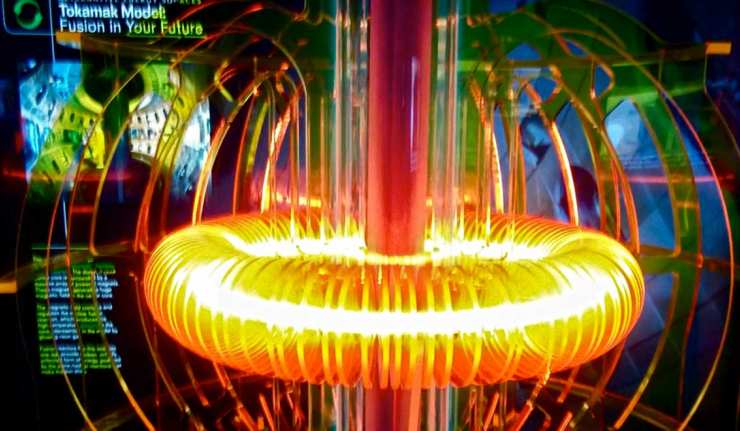Energy
Magnetic Flux Capacity: New Research Shows How To Improve Nuclear Fusion Reactions
Nuclear fusion is a concept for power generation that has been around for some time. These days, research and development in this area are done using up-to-date reactors called tokamaks. These installations may provide the data and insights necessary to bring fusion back into the 21st century.
Score For Tesla: Lithium-Ion Storage Could Be Coming To California Soon
Tesla may appear to be in some trouble these days - their new electric vehicle, the Model 3, is way behind schedule in terms of production, with some customers even canceling their pre-orders over the delays.
New Proposed Project Could Turn Loch Ness Into Monster Power Source
Scotland is a good example of a country that is making a commitment to a future with greener, more sustainable energy. The nation has increased its volume of off-shore wind farms by 37%, recently. However, this investment only means so much in the context of the weather. In calm weather, Scotland may need back-ups in the form of batteries in order to keep constant the current flowing through its grid.
Cost-Effective Technique Of Harnessing Uranium From Seawater For Nuclear Power
Uranium is a heavy metal that is found in nature as U-238 and U-235, and in traces, as U-234. Since the half-life of this element is about 4.5 billion years, it has been useful in determining the age of the Earth. Past research has also indicated that some radioactive isotopes of uranium could possess nuclear properties and cause radiolysis on other planets too.
Hybrid Junctions: The Future Of Photovoltaics?
If they were asked to think of a material to make solar cells, professionals might be inclined to think of perovskite - a mineral strongly associated with photovoltaics or electronics that are activated by light or store it in the form of energy (mostly as sunlight).
Reimagining Lactate: From Bio-Distress Signal To Potential Healer
If someone were to mention the word ‘lactate’ in conversation, you might be inclined to think about why people have stitches in their sides after running.
Classical secondary and tertiary education has taught us that lactate is a kind of muscle-cell waste product that may also be a marker of stress or illness. However, the study of this versatile biochemical product has experienced a considerable upheaval. This concern is due to the re-examining of some possibly faulty correlations made about the molecule and its roles in health and disease.
Green Tech: Don’t Wait For ‘Goldilocks’ Product, Say Researchers
Many of us may be considering adopting or investing in the emerging low-carbon solutions in the market, so as to save both money and the environment. However, we may also be waiting for that perfect piece of technology or innovation that is definitely going to giving us our money's worth.
Nitrogen: The Latest Contender in High-Energy Materials
The energy storage solutions of the future are thought to be those of the high-tech lithium and carbon variety.
These elements have been converted into various atomic-level shapes and states that are purported to improve on current battery technology when set up along other complementary chemicals.
However, there is another player in the potential high-energy research space that may be less obtrusive when it comes to public attention. This element is, surprisingly, nitrogen, which is already associated with a huge range of important attributes in nature and science.
The Electric Eel (Bio) Inspires Development of New Soft Power Cell
In the coming years, with groundbreaking research in the interdisciplinary areas of science, medicine, healthcare and technology, it is possible that chemical batteries we are familiar with will be completely replaced.
Reasons to seek alternatives include bulkiness, instability in extremes of temperature, toxicity of chemicals and low sustenance.
Al Gore Versus Climate Change
Since the release of ‘An Inconvenient Truth’ in 2006, former Vice President of the US, Al Gore, has become something of a spokesperson for those wishing to take action against climate change.
Why Lithium? New Research Revisits Sodium’s Role in Energy Storage
Many modern batteries use lithium, an earth metal, as a medium for energy storage. Earth metals were chosen in the course of solid battery development as their ions have many favourable properties for such applications. Lithium has a high specific capacity (3860 mAhg/m) and also has relatively high electronegativity. However, raw lithium for new batteries is mined and used at ever-increasing rates, which may affect its cost in the long run. Lithium-ion batteries also carry risks of failure, which can damage device lifespan at best and cause harm or injury at worst.
Metallic Paper: A Power Source for Flexible Wearables?
Devices that can be safely bent out of shape, form curves or even fold up could be the next big thing in electronics. These devices are most likely to take the shape of ergonomic wearables that may even be expected to adhere to and remain on the skin for prolonged periods. Besides this putative trend in health and fitness trackers, there are increasingly credible online rumours that Samsung is working on its first flexible-display phone.
Can Renewable Energy Sources Be Protected from Cyberthreats?
The increased need for, and the implementation of renewable or clean energy, questions the premise of its safety and reliability because it brings about the possibility of being threatened by hackers by way of theft or cyberattacks. The magnitude of real-time data and the distributed generation of energy make for easy gateways. Take charging an electric car, for example — a group of such vehicles are ultimately connected to a larger power unit, which can, if jeopardized, compromise the grid of an entire city.
New Battery Prototype Could Give E-Cars 1000km Range
Electric cars are great, in theory. They may help you reduce your personal travel costs, carbon footprint and emissions. However, their range (or distance they can drive on a single charge) may be underwhelming for new customers. The manufacturers of these fossil fuel-free vehicles claim that the range of their electric cars improves every product cycle; however, real-world tests may find that it falls short of maximum ranges on paper. Range depends heavily on the capacity of the batteries incorporated into electric cars.
Powering The World With Wind Turbines
What if we could generate all the energy required to power the whole of civilization, just using wind turbines? It might sound far-fetched but new research published this week has suggested that this scenario is not entirely unrealistic.
A new location for wind farms
It would however, require some significant changes to the location of wind farms – placing these far out in deep water areas of our oceans, as opposed to on land or relatively near to the shore.
Can Renewable Energy Sources be Protected from Cyber Threats?
The increase in need for, and the implementation of renewable or clean energy questions the premise of its safety and reliability because it brings about the possibility of it being threatened by hackers through theft or cyberattacks. The magnitude of real-time data and the distributed generation of energy make for easy gateways. Take charging an electric car, for example — a group of such vehicles are ultimately connected to a larger power unit, which can, if jeopardized, compromise the grid of an entire city.
Clothes that Charge your Phone: Battery-Powered Fabrics
Many of us have come across the concept of human-powered electronics and machines – the most popular example probably being the first Matrix movie or One Million Merits (the Black Mirror episode starring Daniel Kaluuya). However, reading about it on the internet afterwards may have rubbished the mechanics, which are often presented in rather horrible contexts, of getting appreciable amounts of energy out of human motion or physiology.
Future-Proofing Fuel Storage: One More Step Towards a True Hydrogen Economy
Hydrogen derived from water and exploited for its potentially huge energy payload is a substance of interest for those researching post-oil fuels and their uses. Some researchers and inventors conclude that hydrogen is the clean, green solution to humanity’s consistent need for power. The last few years alone have seen a revolution in hydrogen-purification methods. These include studies that have demonstrated chemical reactions that result in efficient and prolonged hydrogen production from solution, also known as ‘artificial photosynthesis’.
Paper-Thin Device Functions As Foldable Loudspeaker And Microphone
The concept of wearable technology has revolutionized not only the fields of health and medicine, but has also found a place in the electronics and appliances in our homes. Since acoustic interactions have become a way of life, a medium connecting humans and flexible wearables is definitely both progressive and convenient.
The Solar Economy: What’s Being Done To Help It On Its Way?
Solar energy involves using highly-specialised and engineered power cells to harvest the energy of sunlight and convert it into electricity that can be used by conventional appliances. Over the last 20 years, this concept has morphed from an unlikely pipe dream into a nearly-standard component of energy use in new buildings. Installations of sunlight-collecting panels in large numbers have become part of the everyday electricity grid in several countries, including China and Spain.




















